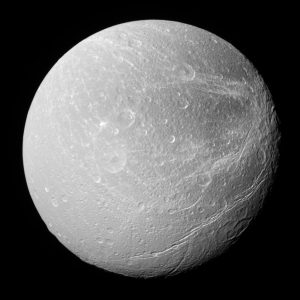
Dione is Saturn‘s fourth-largest moon with a mean radius of 561 km (349 miles), around 0.3 times the size of our own Moon.
Dione’s mass suggests it is composed of roughly 50 per cent silicate rock and 50 per cent water ice.
Dione has a light-grey surface covered in impact craters. Its orbit is tidally locked, meaning the same side always faces Saturn as it orbits the planet, although the leading side is more highly cratered than the trailing side. This suggests that Dione’s orientation once faced the opposite direction.
Dione’s trailing side is also covered in a network of long chasms, ridges and depressions. These ice cliffs, some hundreds of kilometres long and several hundred metres high, were created by tectonic fracturing.
The Cassini spacecraft detected an exosphere (a faint atmosphere) of molecular oxygen ions when it flew close to Dione in 2010.